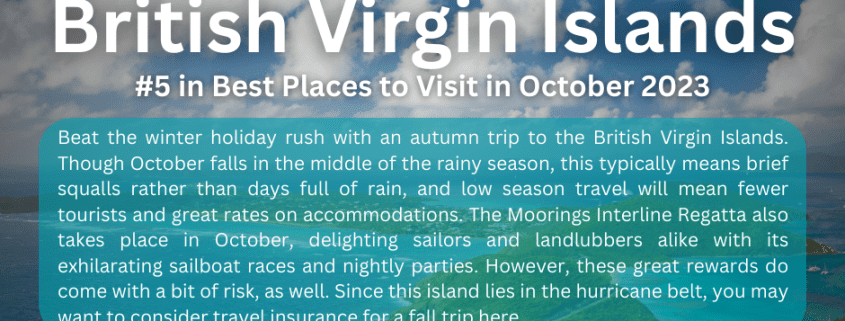British Virgin Islands #5 in Best Places to Visit in October 2023
Why Go To British Virgin Islands
The British Virgin Islands, or BVI for short, are some of the most-exclusive and least-developed islands of the Caribbean, but this only adds to their appeal. The resorts, villas, restaurants and other tourist attractions in this paradise are known to emphasize spare luxury over sprawling expansion, and they attract travelers with deep pockets and a love for sailing and seclusion. Many travelers who visit come by ferry boat from another Caribbean isle, especially as some find opulent exile too hard to enjoy for longer than a day or two. And some say it’s better to split your time between here, the nearby U.S. Virgin Islands and Anguilla to the east.
Others find more than enough to keep them exclusively anchored by these 50-plus islands and cays, which sadly were hit hard by Hurricane Irma in September 2017. Travelers will still be able to find evidence of the hurricane’s handiwork, though BVI has done a valiant job of rebuilding. On Tortola, you’ll find mountainous cliffs and chalk white beaches, characterized by changing tides and calm easterly winds. A brief sail away, sleepy Jost Van Dyke offers delicious Caribbean food and drink, one of the region’s best New Year’s Eve parties, as well as a few outdoor excursions like diving and fishing. On Virgin Gorda, you’ll find The Baths, perhaps the most picturesque shore in the British Virgin Islands, and with good reason: It offers unique grottoes amidst gigantic granite boulders (just be mindful of the daytripping crowds). For supreme seclusion, try Anegada; its slow pace, flat terrain and sparkling sand lies almost overlooked in Caribbean Sea.
Best Months to Visit
The best time to visit the British Virgin Islands is from September to November, before the crushing crowds of the winter holidays. Though the fall months see the highest amount of precipitation, they also welcome some of the lowest hotel rates you’ll find all year. Keep in mind: Hurricane season runs from June to November, so keep an eye on the weather if you’re planning a summer or fall visit. Divers should plan a trip for winter or spring – the summer is the absolute worst time for visibility underwater – and sailors should try to visit in March, during the BVI Spring Regatta.
Culture & Customs
The British Virgin Islands comprise four larger islands – Tortola, Anegada, Virgin Gorda, and Jost Van Dyke – and 50-some smaller islands and cays. They’re a British overseas territory, and as such its culture is a mix of European, Caribbean and African facets. Often called “the Sailing Capital of the World,” boating is a popular pastime in BVI. Football (or soccer) and cricket are other popular sports, which hail from the BVI’s English heritage.
The official currency of the British Virgin Islands is the dollar, and travelers will need a lot of them on a BVI vacation.
Virgin Islanders dress casually but conservatively. Wearing a bathing suit – or even sandals – anywhere besides the beach marks you as a tourist. Most nightclubs are willing to accept you in boat shoes and a nice pair of shorts, but don’t be surprised to find the residents in slightly better attire.
What to Eat
Since the British Virgin Islands are located in the Caribbean, it should come as no surprise that seafood is a big part of the dining scene. Expect to find Caribbean spiny lobster, conch and fresh fish like mahi mahi and grouper on menus at various eateries throughout the islands. BVI’s national dish is “fish and fungi.” Okra and cornmeal are boiled with butter and then flattened into a cake and served with braised fish, which is cooked with tomatoes, onions and other traditional spices.
Heavily spiced dishes are standard throughout the BVI, with chefs using everything from sea salt and pepper to strong curry, nutmeg, garlic powder and jerk seasoning. You should also try a painkiller when you’re looking to wet your whistle. This alcoholic drink originated in the British Virgin Islands and typically consists of pineapple juice, orange juice, cream of coconut and a hefty dose of rum, garnished with fresh nutmeg.
When it comes to eating out, there aren’t a wealth of dining options available as many people visiting the islands charter boats with their own chefs or are just staying for the day. However, there are a few mainstay bars and restaurants on Jost Van Dyke, Virgin Gorda and Tortola that travelers say are worth a visit. Anyone heading to Jost Van Dyke would be remiss if they didn’t spend a few hours savoring drinks at Foxy’s Tamarind Bar & Restaurant. It’s known to host a raucous New Year’s Eve celebration but it’s just as festive the other 364 days of the year. The drinks, music and atmosphere make this one of the most fun bars around, according to travelers.
On Tortola, you’ll find some traditional Caribbean fare and tasty seafood at the popular Sugar Mill Restaurant, which is currently closed and undergoing renovations due to hurricanes Irma and Maria. Travelers will find some terrific sunsets and Caribbean fusion cuisine at the BananaKeet Café. For more upscale fare, visit the Dove Restaurant & Wine Bar in the BVI capital of Road Town. On Virgin Gorda, experts and visitors suggest meals at the beachfront, seafood-centric CocoMaya Restaurant or the open-air (but pricey) Pavilion at Little Dix Bay.
Safety
Crime is rare and hardly a concern for most BVI travelers. Your biggest safety hazard will be avoiding livestock as you try to navigate the many narrow dirt roads of the British Virgin Islands. But your best bet for avoiding the islands’ goats, chickens and sheep is not renting a car at all: Between the animals, the left-side driving and the unpaved dirt paths masquerading as roads, it’s not worth it.
Getting Around British Virgin Islands
The best way to get around the British Virgin Islands is on a boat. You might even need one to arrive at your destination first – there are no direct flights from the United States to this island chain and many people fly into Cyril E. King Airport (STT) on St. Thomas in the U.S. Virgin Islands and then ferry over. You could also take a connecting flight from Puerto Rico, St. Thomas, Antigua, or St. Maarten to Tortola Airport (EIS). Once you’re settled, you might end up on the water again – to ferry or to sail between the numerous islands that make up this archipelago. You should rent a car or take a taxi to move about larger islands like Virgin Gorda or Tortola.
Boat
You’ll probably get on a boat at least once during your vacation – either because that’s the way you arrived in the British Virgin Islands or that’s the way you traveled among them. And fortunately, there are plenty of on-the-water options. Ferries travel between Tortola and Virgin Gorda as well as to the U.S. Virgin Islands, plus there’s also a ferry link between Tortola and Jost Van Dyke and Peter Island. Keep in mind that there are two docks in Tortola, one on the West End and one in Road Town. If you have a mind to splurge, you can also charter your own boat for transport to and from surrounding islands and cays.
Car
It’s possible and convenient to rent a car on the larger islands of Virgin Gorda and Tortola. On Virgin Gorda you can find agencies across from the yacht harbor; in Tortola, the agencies are located outside Road Town near the ferryboat dock. You’ll need a valid driver’s license. Remember to drive on the left, and keep your eyes peeled for potholes, blind curves and maybe even a few cows, roosters and iguanas, especially on Anegada.
Taxi
Taxis are a hassle-free way to move around most of the islands. There are stands near the ferry docks and at the airports, but hotels on the more developed islands are willing to call one for you. The cabbies are obviously better prepared to navigate the island than you will be, but they’re also pretty good tour guides. There is, however, some expense involved. Each island or cay has different taxi rates: You can check BVI Tourism’s website to get an idea on what the price for your destination might run. Keep in mind that the price is determined by the distance traveled and the number of persons in the vehicle.
Bus
For cheap transportation to well-known tourist spots, you can take an open-air safari bus. They hold approximately 20 people and charge between $2 and $5 for a one-way trip from the ferry dock to a popular spot like The Baths of Virgin Gorda. This is an especially efficient option if you’re just visiting an island for one day. Van-type buses, most often seen on Tortola, are less practical if you’re just generally trying to move around town.
Entry & Exit Requirements
You’ll need a valid U.S. passport with at least one blank page to travel to the British Virgin Islands and to re-enter the United States. Upon arrival on the islands, you’ll also need to present proof of return flights or continuing travels, and you can anticipate a departure tax when you leave. Occasionally, officials will also ask to see proof of sufficient funds to cover your visiting expenses. Visit the U.S. State Department’s website for the latest information on foreign entry and exit requirements.
Start Saving with iTravelDirect’s Exclusive Travel and Lifestyle Benefits Membership
CLICK HERE to Test-Drive our Guaranteed Savings
We offer a 110% Price Guarantee – Find a lower price anywhere online and we will refund you 110% of the difference.
CLICK HERE for a full list of services and Membership Discounts.
When you join iTravelDirect, you’ll have full access to all club benefits.
Your membership gives you the freedom to travel when you want, to where you want.
And you won’t find lower rates anywhere, guaranteed. So, pack your bags and start planning that vacation of a lifetime today!












Leave a Reply
Want to join the discussion?Feel free to contribute!